Building a transparent veterinary practice-with glass, open spaces and values
By breaking down barriers, you can give your clients an exceptional veterinary hospital experience.
Next >
Recently, I found myself looking at a large, flat-screen monitor on the wall of an exam room in a suburban family medical practice. I thought I'd be subjected to an infomercial on the benefits of sunscreen. I was surprised when the doctor displayed my chart on the monitor—complete with records, notes and lab results.
Often it's those little unexpected conveniences and service touches that make the difference between an OK experience and a great one. The chart-on-the-monitor idea is a little thing, but it represents the idea of transparency, which is hugely appreciated in the murky world of healthcare.
Transparency is even easier to accomplish in veterinary medicine. Veterinarians are free of most of the bureaucracy muddying up physicians' practices. There are still some important considerations about privacy, safety and basic decorum, but in general, veterinary doctors are free to dismiss the barrier between themselves and their clients. In fact, this has always been the norm in equine medical practices, where clients typically hang around, watch and generally get underfoot.
How does transparency relate to improving customer service? Customer service consultant Micah Solomon asked this question: “If you want to build customer loyalty, start by making a decision: Are you willing to put the customer at the center of everything you do?”
Click next to learn how transparency relates to client service and why clients are saying, “show me, don't tell me.”
Looking at open lobbies
To see transparency influencing client interactions, let's first take a look at how reception areas have evolved. This little remodel, completed 10 years ago for Dr. Steve Hotchkiss in Fort Worth, Tex., is still one of my favorites. In the “before” version, the reception staff look about as approachable as Department of Motor Vehicles employees.
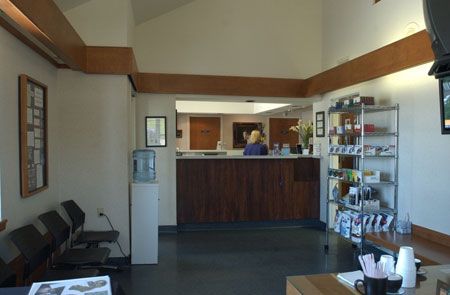
Photo credit: Dr. Steve Hotchkiss
Click next to see the "after" version.
The new desk is a huge improvement, not just because of the way it opens the space, but because it puts the receptionist much closer to the client.
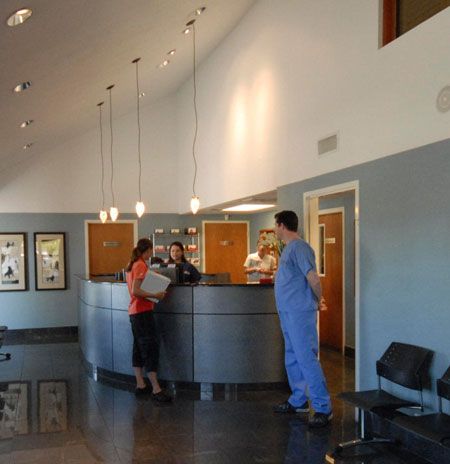
Photo credit: Dr. Steve Hotchkiss
Many practices have already reduced the desk to its smallest form and turned the receptionist into a greeter. Why not take the next step by decentralizing the desk entirely? I saw this concept applied at the Peninsula Area Humane Society in San Francisco. The shelter features an open reception area where adoption counselors equipped with iPads meet potential adopters in several comfortable seating areas. Talk about putting the customer first!
Bringing together clients and patients
While we're talking about barriers, let's think for a moment about the barrier between the client areas of your hospital and the medical spaces. We assume it needs to be there, but does it? Again, in equine hospitals, practitioners are accustomed to doing everything in front of their clients, including exams, procedures, specialty imaging and even surgery. While this may not work in a small animal practice, there are many ways you can surprise your clients by welcoming them to participate.
One current trend is to perform specialized wellness procedures such as acupuncture in the room with the client. Your client isn't required to help, but simply having them there can be gratifying for them and can have a positive influence on their pet's behavior. For the pet owner and for your practice, the benefits last far longer than the procedure. It's easier to build a following of loyal customers if they understand what you do and feel welcomed to be a part of it.
DTLAvets in Los Angeles, Calif., features dedicated acupuncture rooms with convertible couches so both patients and clients are comfortable during treatment.
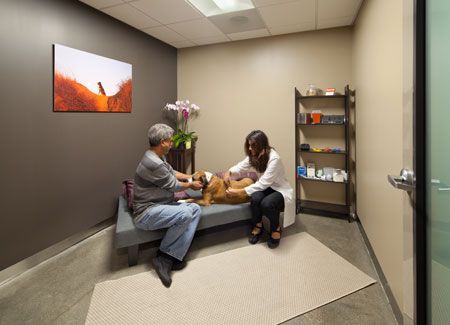
Photo credit: Jim Simmons Photography
Some hospitals have gone the extra mile to provide places where clients can visit their critically ill pets. This isn't an easy thing to do, as it involves putting your clients right in the middle of things, but it may be worth the design challenge. A worried owner will appreciate the chance to be close to their loved pets.
At Pet Crossing Animal Hospital and Dental Clinic in Bloomington, Minn., this recovery space was implemented and clients really appreciate it.
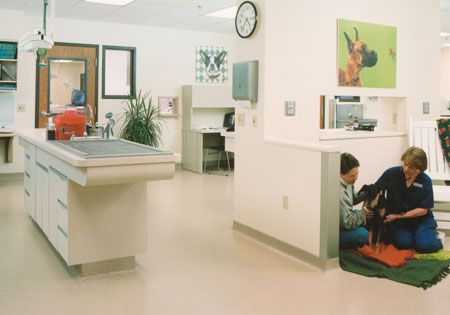
Photo credit: Dana Wheelock, Wheelock Photography
Communicating with clients
At the most basic level, the idea of transparency simply means being approachable. Dr. Stew Silverman at Melrose Animal Clinic in Melrose, Mass., spends time hanging out in front of his reception desk, rather than behind it. I really like this simple idea.
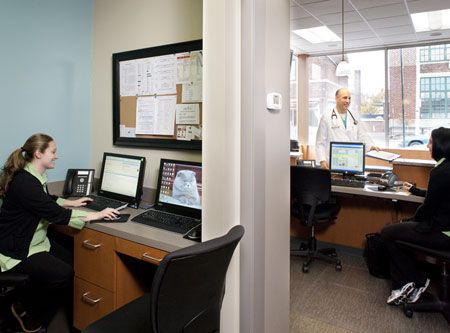
Photo credit: Tim Murphy, FotoImagery
Trying to open up treatment
Transparency is also a great metaphor for your work areas. While the idea of open medical spaces isn't new, we continue to hear encouraging feedback about working in a visually connected space. The benefits go beyond basic communication to general staff efficiency and better outcomes for patients.
PetCare Veterinary Hospital in Santa Rosa, Calif., was on board with the idea of “glass everywhere.” Prior to building their second location, all of their services were crammed into a series of enclosed spaces. When they added the second hospital, they were surprised they could operate both locations with the same number of employees. They think that improved efficiency has a lot to do with this. For example, critical cases are treated at the new hospital, where glassed-in, centrally located wards make monitoring cases easier. Crises are averted, and everyone pitches in to help when and where they are needed.


Photo credit: Tim Murphy, Foto Imagery Ltd.
Ultimately, better efficiency makes for improved profitability, and this helps you justify going the extra mile for your clients.
Tearing down walls
Even if you're not ready to build a new hospital, think about what you could do with a few simple changes. In the family medicine practice I described, the doctors and nurses take notes in the chart while you follow along on the screen. It takes more time, but the approach has earned the practice a loyal following, regional recognition and tremendous success.
If you want to increase your hospital's transparency in ways that don't entail construction, one small change you can make is to provide more online services for clients to create an easier interface with the hospital. This might include the ability to schedule appointments, renew prescriptions and contact the clinic. Another option is to open up the hospital visually by offering clients tours of some of your practice's medical spaces or install webcams with views into select areas of the hospital.
What could the demolition of a few walls—real and imagined—do for your practice?
Heather Lewis, AIA, is a partner at Animal Arts, a veterinary design firm based in Boulder, Colo.







